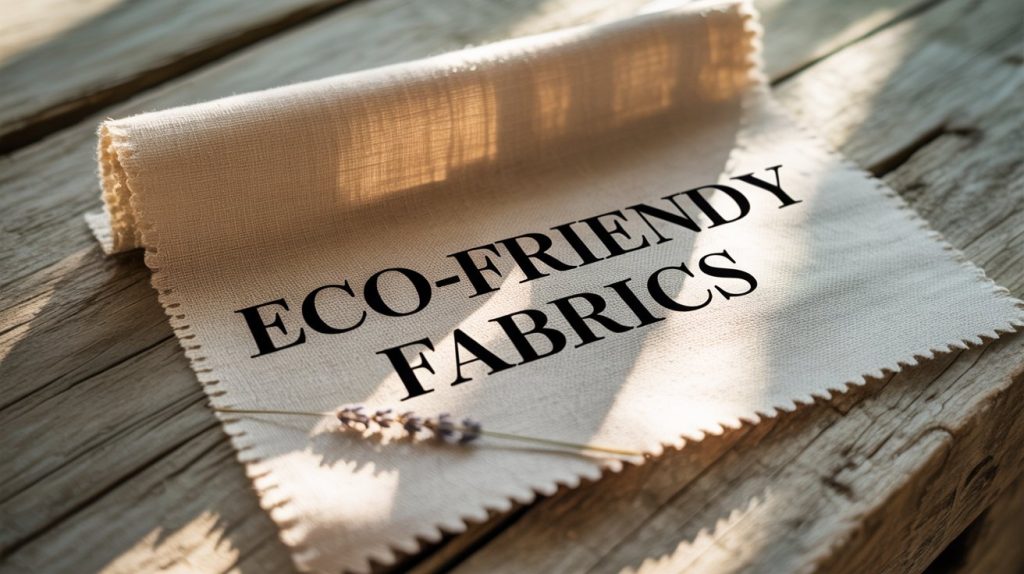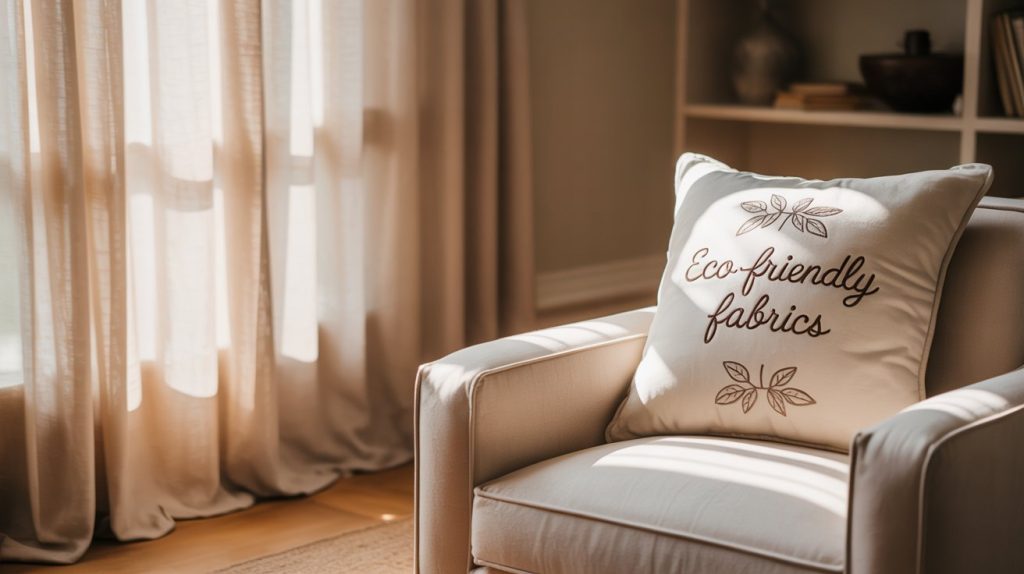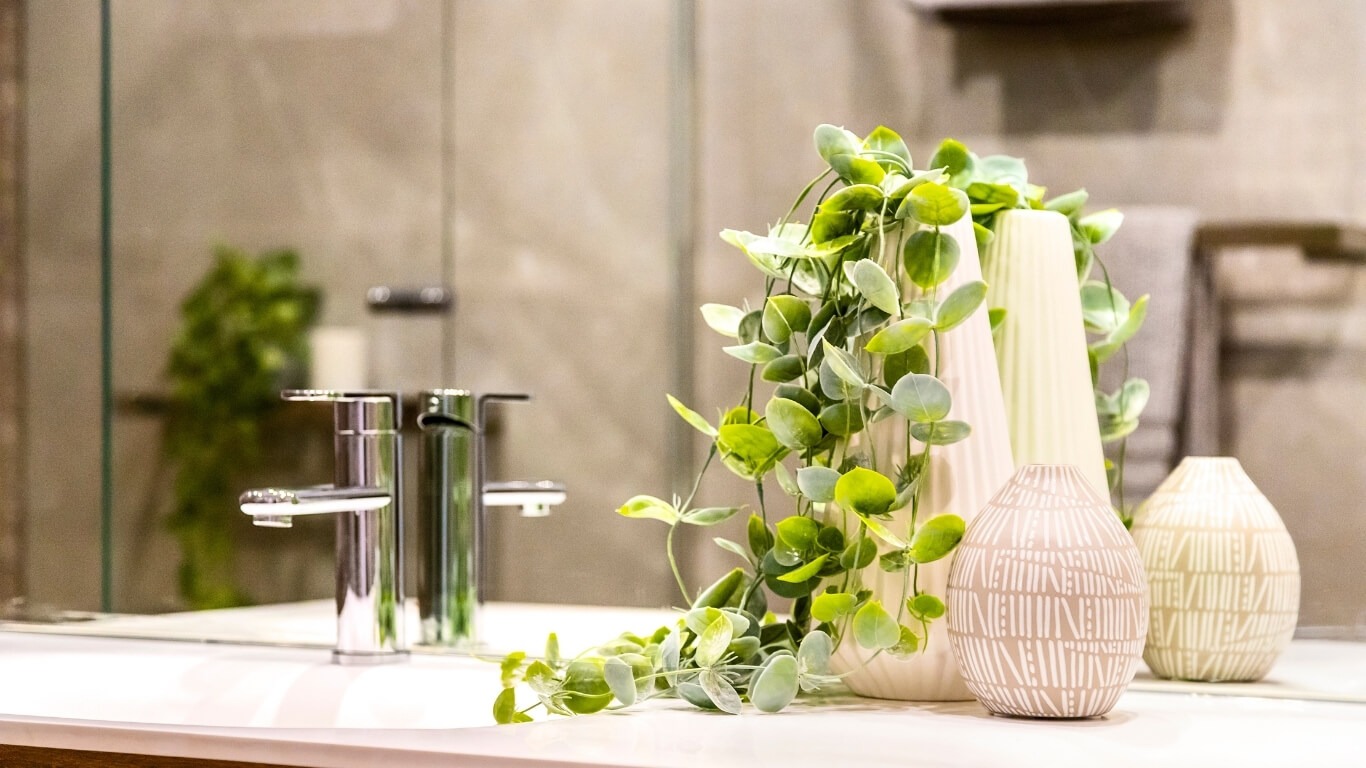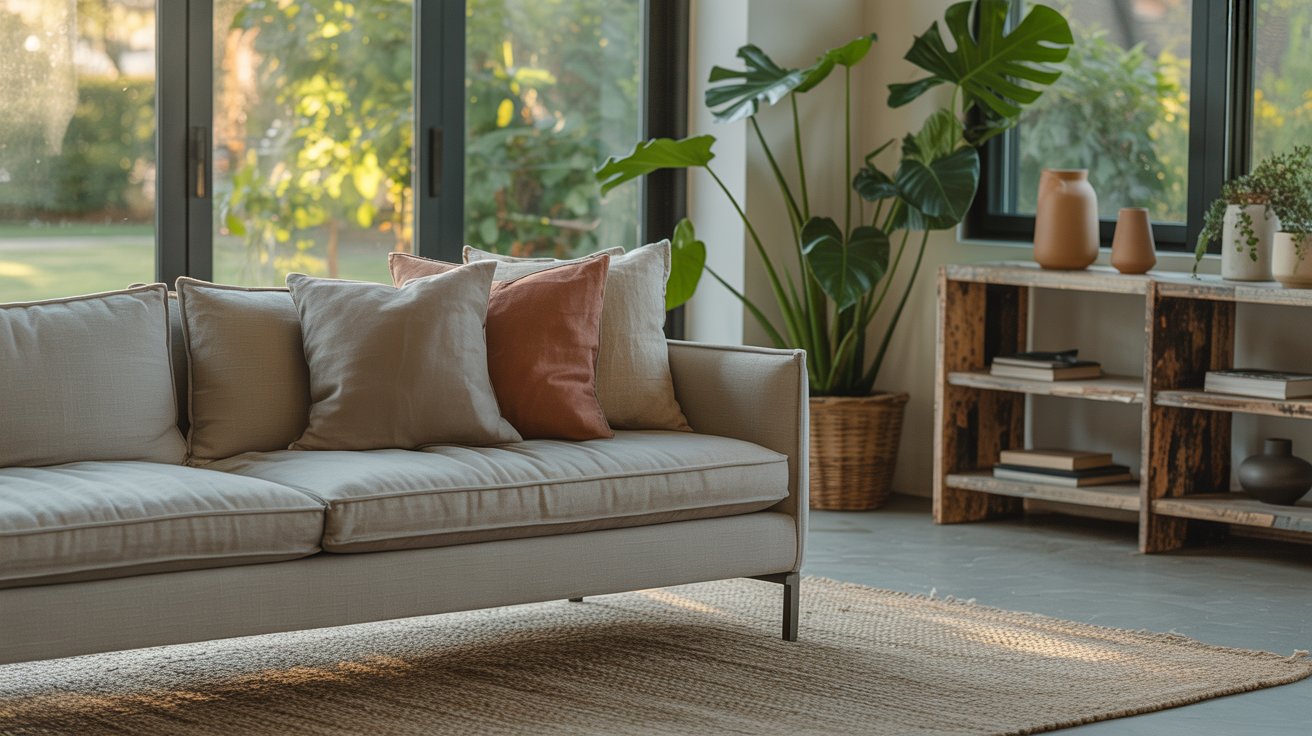10 Eco-Friendly Fabrics for Curtains, Cushions, and More

Ever think about what your curtains and cushions are really made of? Maybe you’ve wondered if there’s a better option for the planet—and for your well-being—than just picking whatever matches your sofa. The good news? There’s a growing world of eco-friendly fabrics that look stylish, last longer, and are safer for your home.
You spend a lot of time surrounded by textiles—on your windows, your favorite reading chair, that pile of cozy pillows on the couch. But most fabrics on the market use plastic fibers, harsh chemicals, or unsustainable farming methods that can quietly impact both your health and the environment. Also, how many of us really know what “sustainable” even means when it comes to fabric labels?
Choosing cleaner, greener fabrics isn’t just about keeping up with trends. It can mean less waste, fresher air inside your home, and fewer harmful chemicals where your family relaxes. Plus, you don’t have to give up on style or comfort. Sustainable options are now easier to find and come in every look you love.
Ready to rethink your home’s soft furnishings? Dive in and discover 10 top eco-friendly fabrics for curtains, cushions, and more—plus clear tips on picking, caring for, and enjoying them. A healthier, more stylish home starts with what you choose next.
Understanding Eco-Friendly Fabrics: What Makes a Fabric Sustainable?
Now that you see why choosing eco-friendly fabrics matters, let’s dig into what makes a fabric truly sustainable. You’ll see it’s more than a green label or trendy buzzwords. Real sustainability looks at the life cycle of the fabric, from the raw materials to how it’s made and even how workers are treated.
Natural and Biodegradable Materials: Linen, Cotton, Hemp
First, the backbone of eco-friendliness is the material itself. Fabrics like linen, organic cotton, and hemp pop up again and again in every trustworthy guide. Why? They come from plants that grow with little water and don’t need chemical-heavy farming.
For example, linen is made from flax, a hardy plant needing minimal water and pesticides. As Foam and Covers explains, linen biodegrades naturally and lasts for years, making it both earth friendly and wallet friendly.
Hemp is a powerhouse, too. It’s durable, needs little water, and grows fast without pesticides. As you’ll find at shops like Cushion Warehouse, hemp is showing up in more cushion and curtain collections meant to last. Organic cotton is another star—it’s grown without synthetic chemicals, so it’s better for the soil and your indoor air.
Importance of Eco-Certifications: Oeko-Tex, GOTS, Fair Trade
But let’s be honest, it’s hard to trust every “green” claim. Certifications matter here. If a fabric is Oeko-Tex certified, like MagicLinen’s and LinenTales’ linen curtains, it’s been tested to be free from harmful chemicals.
GOTS (Global Organic Textile Standard) goes further, covering strict organic growing guidelines plus ethical factory standards.
You’ll also spot Fair Trade certifications in top brands like West Elm and Pottery Barn, which means workers get fair wages and safe conditions. That’s more than just fabric—that’s ethics woven in.
Avoiding Harmful Chemicals and Toxic Finishes: VOCs, PFAS, Formaldehyde
It’s not just about what goes into the fabric, but what’s left out, too. Regular fabrics can be treated with nasty stuff like formaldehyde (to make them “wrinkle-free”), PFAS (“forever chemicals” that don’t break down), or other toxic finishes. These can off-gas into your home, leading to poor indoor air quality. As stated in several guides (including Conscious Life & Style), the safest picks skip these chemicals entirely.
For example, Rawganique guarantees their hemp and linen curtains are VOC-free and never chemically treated. Avoiding “stain-resistant” or “easy care” labels is a great rule of thumb if you want a healthy home.
Ethical Production: Fair Labor, Traceable Supply Chains
True sustainability also respects people, not just the planet. Look for brands that share clear info about who makes their products and where. Small European makers like Epic Linen spotlight hand-sewing in their own workshops.
Others, like Made Trade, work with artisan groups using fair labor—and many now post factory photos and stories online.
Transparency, ethical audits, and Fair Trade labels signal that brands aren’t cutting corners on human rights.
So, a sustainable fabric should be plant-based or recycled, safe for your home, and made ethically. Remember these points, because up next, I’ll walk you through the top 10 eco-friendly fabrics you can use for curtains, cushions, and more—each with real-life benefits and brand examples to make your decision a breeze. Ready to meet your new favorite materials? Let’s look at what’s out there!
The Top 10 Eco-Friendly Fabrics for Home Textiles
Building on what we just discussed about true sustainability, it’s time to see your fabric choices in action. Below, you’ll find a clear, no-nonsense guide to the top 10 eco-friendly fabrics used for curtains, cushions, and soft furnishings—each one explained with real benefits and examples straight from industry leaders.
1. Linen: Renewable, Durable, and Timeless
Linen stands out as a sustainable all-star. Made from flax, it grows fast with minimal water and pesticides—much less than cotton. Linen is strong (three times stronger than cotton), and it’s fully biodegradable. You’ll find it in collections by MagicLinen, LinenTales, and Sanderson Linens.
These brands create everything from soft, stone-washed sheers to sturdy drapes, often Oeko-Tex certified for chemical safety. Linen lasts for years, resists stains, and brings a classic look to any room. It keeps rooms cool in summer and adds a layer of natural warmth in winter.
2. Organic Cotton: Soft and Versatile
Organic cotton is gentle on both people and the planet. Brands like Pottery Barn and William Morris & Co. use it for curtains and cushions. Unlike conventional cotton, organic varieties rely on natural methods—no synthetic pesticides needed.
You get a plush, breathable fabric that’s safe for sensitive skin. Organic cotton adapts to both formal and casual spaces; it’s as at home in a kid’s bedroom as it is in a living room.
3. Hemp: Durable and Low Water Use
Remember when we talked about material impact? Hemp is a high performer here. It grows rapidly, barely needs water, and thrives without pesticides. Rawganique and Crate & Barrel feature hemp curtains that last for years, even in busy homes. It has a crisp, slightly textured feel—ideal for both modern and rustic spaces. Hemp curtains hold their shape and outlast many other natural fibers.
4. Bamboo: Rapid Growth and Hypoallergenic Properties
Bamboo is gaining fans for a reason. This fast-growing plant doesn’t need much water and regenerates quickly after harvest. Bamboo fabric feels silky soft and is naturally hypoallergenic, so it’s great for kids and people with allergies. The material also has antibacterial qualities, helping you maintain a healthier home environment.
5. Recycled Polyester: Reducing Waste
Let’s talk about turning trash into treasure. Recycled polyester, made from plastics like water bottles, helps reduce landfill waste. Brands such as West Elm offer GRS (Global Recycled Standard) certified options. These fabrics look and feel almost identical to traditional polyester but use up to 80% less energy in manufacturing. Plus, they’re tough—ideal for homes with kids or pets.
6. Wool: Renewable and Biodegradable
Abraham Moon makes wool curtains using methods honed since 1837—no joke! Wool is both renewable and biodegradable. It regulates temperature well, so your curtains can help keep your home cozy in winter and cool in the summer. And wool naturally resists fire and stains, making it practical for busy spaces.
7. Tencel/Lyocell: Closed-Loop Processing and Biodegradable
Next on the list: Tencel, sometimes called Lyocell. It’s made from wood pulp (usually eucalyptus), in a closed-loop process that recycles water and solvents. This results in a super soft, moisture-wicking, and biodegradable fabric. Tencel breathes like cotton but drapes more elegantly—a go-to for sleek, modern decor.
8. Silk: Natural Luster with Minimal Processing
If you want luxury without guilt, silk is worth considering. Crate & Barrel, for example, offers silk curtains that rely on natural processing—no harsh chemicals. Silk is strong for its weight, naturally hypoallergenic, and adds a gentle sheen to any space.
9. Blends with Recycled or Organic Components
You’ll also see eco-friendly blends in collections like Ashley Wilde’s Wisley range. These combine natural fibers with recycled materials, balancing durability and sustainability. Blends are ideal if you want extra resilience without giving up green credentials. They offer style, strength, and a smaller footprint.
10. Upcycled and Repurposed Fibers
Finally, upcycled options take pre-loved textiles and give them new life. Just Fabrics’ recycled cloths are a prime example—they use 100% recycled cotton, sorted by color to skip bleaching and dyeing. This means less chemical use and a truly unique look for your home.
That’s a quick tour of the top eco-friendly fabrics shaping modern interiors. Curious about which brands are leading the way, or how to spot a truly sustainable name? Up next, we’ll highlight the companies setting the gold standard for eco-conscious curtains and cushions.
Brand Highlights: Leading Names in Eco-Conscious Curtains and Cushions
Now that you know what makes a fabric truly sustainable, let’s look at the brands walking the talk. These companies don’t just tout green values; they back them up with real certifications, artisan craftsmanship, and clear supply chains. You’ll spot familiar retailers as well as small, specialist producers—each making eco-friendly living easier for you.
MagicLinen and LinenTales: Handmade Linen Curtains from Lithuania
Building on the earlier conversation about linen’s amazing benefits, MagicLinen and LinenTales both stand out for their handmade approach. Each curtain is crafted in Lithuania, using locally sourced flax.
MagicLinen offers panels in soft, earthy tones, all Oeko-Tex certified—so you don’t have to worry about hidden toxins. The attention to detail is clear: compostable packaging and a drive to reuse fabric leftovers, even creating unique decorations from scraps.
LinenTales brings the same spirit of sustainability, with their stone-washed 100% linen curtains that filter light beautifully. Their daytime options are semi-sheer, while nighttime versions are thicker for privacy.
Every product is OEKO-TEX® and European Flax® certified, giving you full peace of mind. Both brands deliver comfort, style, and a lighter environmental footprint.
Pottery Barn and West Elm: Large Retailers Moving Toward Sustainability
As we discussed with organic cotton and linen, big names like Pottery Barn and West Elm are increasingly serious about sustainability. Pottery Barn offers curtains made from Fair Trade and Better Cotton Initiative-certified cotton as well as Belgian linen, often with Oeko-Tex certification.
Their supply chain transparency and range—curtains for every style, even kids’ rooms—mean more people can access healthier home textiles without giving up convenience. Meanwhile, West Elm goes the extra mile, with more than half its curtains coming from Fair Trade certified facilities.
This ensures fair pay and safe conditions for workers—a rare find in mass retail. You’ll also see recycled polyester and GRS (Global Recycled Standard) certifications show up for those wanting to cut down on plastic waste. These retailers prove big steps can happen in big stores.
Rawganique and Linoto: Organic Hemp and Linen Specialists
If pure, chemical-free is your top priority, Rawganique and Linoto excel. Rawganique’s hemp and linen curtains are VOC-free and never chemically treated. They even offer undyed and unbleached options—so you get natural shades and absolute peace of mind. Linoto focuses entirely on linen, making custom curtains right in New York using 100% linen in countless colors and sizes.
Both brands handle their own production (Rawganique does in-house manufacturing), avoiding the hidden risks of outsourcing and guaranteeing their exacting eco standards. Their fabrics offer serious durability, ideal for you if longevity matters as much as low toxins.
Fibre Naturelle, Blendworth, and Scion: UK-Based Designers Focusing on Eco Materials
Shifting across the Atlantic, UK labels like Fibre Naturelle, Blendworth, and Scion show how sustainability blends with designer style. Fibre Naturelle’s focus is clear: biodegradable, natural fibers like cotton and linen with a stylish UK twist.
Blendworth’s Botanique range is a top pick, using earth-friendly fibers and dyes. Scion integrates sustainable practices into collections like the Cedar range with organic cotton and low-impact dyes. Their lines offer everything from subtle neutrals to playful prints, making eco fabrics feel truly high-end.
Fair Trade and Artisanal Brands: Bolé Road Textiles, Made Trade, April Notes
Remember earlier when we mentioned the impact of Fair Trade and local, artisan production? Brands like Bolé Road Textiles, Made Trade, and April Notes take this to the next level. Bolé Road’s curtains are handmade in Ethiopia, supporting craft traditions and fair wages.
Made Trade curates over 130 ethical makers—including block-printed or handwoven curtains by artisan groups in India. April Notes opts for on-demand manufacturing, cutting down on textile waste and focusing on natural linen and wool, all thoughtfully packaged in biodegradable materials. These companies help you support global communities, get something truly unique, and reduce the waste associated with mass-produced decor.
With these brands leading the way, you’re spoiled for choice when it comes to genuine sustainability. Next, let’s explore how choosing eco-friendly fabrics makes a real difference for your home, your health, and the environment.
The Environmental and Health Benefits of Choosing Sustainable Fabrics
Building on the standout brands and the top fabrics we just explored, let’s get into why these choices really matter. You’re not just picking a fabric—you’re reshaping the impact your home has on the planet and the health of everyone living there. Let’s walk through the real-world benefits, step by step.
Reducing Resource Use: Water, Energy, and Chemical Inputs
Eco-friendly fabrics help conserve valuable resources. For example, linen production uses 60% less water than cotton—flax grows in rain-fed fields, needing little irrigation or pesticides (FreshineLife, 2025). Hemp, found in high-quality fabrics at Cushion Warehouse, thrives on minimal water while avoiding heavy chemical sprays. Bamboo, another green star, regenerates with so little input that farmers barely need to intervene.
Compare this with traditional fabrics: regular cotton consumes about 2,700 liters of water just to make one shirt. Mass-market polyester and PVC don’t just require energy—they’re derived from petroleum and use tons of chemicals, from dyes to finishing agents that can stick around long after production (Sustainably Chic, 2024). By shifting to natural, organic, or recycled choices, you help cut the demand for these thirsty and chemical-heavy processes.
Lowering Carbon Footprint: Insulation, Local Production, and Recycling
Keep in mind, sustainable fabrics do more than just save water. They help lower your home’s overall carbon footprint. When you use local or regionally sourced linen—a standard for MagicLinen and LinenTales—you cut down on long-haul shipping emissions (Conscious Life & Style, 2025).
And many eco-friendly curtains, whether made from wool by Abraham Moon or linen by Epic Linen, double as smart insulation. They help block out heat in summer and keep warmth inside during winter. Freshinelife.com even highlighted that the right window treatments can reduce heating costs by up to 25%.
That means you save money and help the planet!The benefits stack up when you choose recycled polyester from GRS-certified suppliers at West Elm: it uses up to 80% less energy than virgin polyester. One ton of recycled polyester saves six tons of water and prevents a ton of oil from being used (Freshinelife). This is a real, measurable impact every time you buy or recommend a recycled option.
Healthier Indoor Air: Non-Toxic, VOC-Free, and Allergen-Free Fabrics
Let’s get real—your wellbeing is just as important as sustainability. Many traditional textiles, especially PVC or “wrinkle-free” options, off-gas VOCs and other harsh chemicals into your living space (Conscious Life & Style). These can cause headaches, allergies, and long-term health issues.
Luckily, brands like Rawganique guarantee VOC-free and chemical-free hemp and linen options, while I Love Linen refuses to use formaldehyde or other toxic finishes.
OEKO-TEX and GOTS certifications, which you’ll see on top performers from Pottery Barn, MagicLinen, and others, confirm that fabrics don’t contain harmful substances. You get cleaner air and fewer allergy triggers—key if anyone in your home has asthma or sensitivities.
Supporting Circular and Ethical Supply Chains
As we touched on earlier, going green isn’t just about fibers—it’s about people and systems, too. Many leading brands now prioritize small-batch or made-to-order production, drastically reducing waste and unsold inventory (April Notes, Rough Linen).
You also see a shift towards using upcycled materials—like Just Fabrics’ 100% recycled clothes, which come pre-sorted by color so they skip energy-hungry bleaching and dyeing.
Ethical sourcing matters, as highlighted by the growth of Fair Trade and artisan-led brands.
Whether you’re supporting Bolé Road Textiles (handwoven in Ethiopia and supporting local crafts), or the traceable supply chains at Epic Linen and Made Trade, every purchase doubles as a vote for better labor practices and community resilience.
All these factors combine to create a real difference for you, your family, and the planet. Choosing eco-friendly fabrics isn’t just a personal preference—it’s public health, climate action, and social responsibility all rolled into your home decor. Up next, let’s get practical: I’ll guide you through how to pick and care for these sustainable fabrics, so your choices last for years and keep delivering on their promise.
How to Choose and Care for Eco-Friendly Home Fabrics
Now that you know why sustainable fabrics matter and which brands are leading the way, let’s get practical. Picking the right eco-friendly textiles for your home—and keeping them looking their best—takes just a little know-how. You want your choices to fit your lifestyle, last for years, and actually make a difference. So, let’s dive into how you can do just that.
Assessing Durability and Maintenance Needs: Linen, Hemp, Bamboo
Remember the durability we talked about with linen and hemp? These fabrics shine because they’re not just green—they’re tough. Linen, made from flax, is three times stronger than cotton and resists daily wear (Freshinelife.com). That means fewer replacements and less waste. Hemp is another star here.
It resists stretching, holds its shape, and shrugs off stains, making it perfect for busy homes with kids or pets (Foam and Covers; Cushion Warehouse).
Bamboo scores high for softness and has hypoallergenic benefits, but it can be more delicate. It’s best for places where heavy traffic isn’t an issue—think bedroom curtains or decorative cushions. For all these fabrics, check the tag. Most linen and organic cotton can be machine washed gently with mild detergent. Hemp does well with cold washes and air drying. Bamboo should be washed in cool water and dried flat to avoid damage.
If you’re short on time or need easy maintenance, gravitate toward recycled polyester blends. These tough materials from brands like West Elm (GRS certified) handle frequent washing and don’t wrinkle much. In short, ask yourself: Do you need ultra-tough fabric for the family room, or something soft and special for a quiet corner? Your answer will point you to the right choice.
Matching Fabrics to Interior Style and Function (Light, Insulation, Aesthetics)
Building on your understanding of durability, let’s talk about making sure your fabrics match your space. It’s about more than just color—eco-friendly textiles can completely change how a room feels and functions.
For bright, airy rooms, linen and semi-sheer organic cotton curtains are unbeatable. Brands like LinenTales and MagicLinen offer semi-sheer panels that gently filter light but still give you privacy (Sustainably Chic). Stone-washed linen adds relaxed texture, while natural-wrinkle looks fit a laid-back, modern style.
Need more insulation? Go for thicker weaves or double-layered fabrics like wool (Abraham Moon) or heavyweight hemp. As shared earlier, proper curtains can lower heating costs by up to 25%—that’s a real saving and extra comfort in winter (Freshinelife.com).
Don’t forget color and pattern! Upcycled and recycled fabrics, like the pre-sorted cottons from Just Fabrics, bring unique character without new dyeing. Neutral tones from Pottery Barn or Scion’s playful prints show how much variety exists with sustainability in mind. You can even grab custom lengths and special order shades from makers like Linoto or Epic Linen.
Bottom line: Choose light fabrics for openness and soft color; go richer and denser for privacy and warmth. Most of all, pick what feels happy and welcoming for your family.
Interpreting Certifications and Product Labels (Oeko-Tex, GOTS, EcoCert)
Now that you know what to look for in fabric function and feel, it’s time for a little label literacy. Eco-certifications are your shortcut to trustworthy choices—no more guessing if that “green” label really means anything.
Look for Oeko-Tex, which means the textile has been tested free of harmful substances (MagicLinen, LinenTales, I Love Linen). GOTS (Global Organic Textile Standard) is even stricter, covering how fibers are grown and processed—great for organic cotton and linen (Pottery Barn, West Elm).
EcoCert guarantees the organic origin of plant-based fibers, so if you see it on your product, you know the material was grown with rigorous care (I Love Linen).
Some brands also use Fair Trade or SA8000 certifications. These aren’t about the fibers themselves, but about the workers—guaranteeing safe conditions and fair pay (as seen at Pottery Barn, Bolé Road Textiles, and I Love Linen). Need a quick checklist? Look for the Oeko-Tex logo, the GOTS stamp, or EcoCert label on the tag or product page. If a brand can’t show any certification—or is vague about their supply chain—honestly, it’s smart to keep looking.
Certifications matter most when you want to avoid hidden chemicals or want proof the fabric is as ethical as it sounds. Don’t settle for less.
Care and Cleaning: Extending Fabric Life and Reducing Waste
Lastly, taking care of your sustainable fabrics means they’ll take care of you—and the planet—longer. As covered earlier, natural fibers like linen, hemp, and organic cotton can often be tossed in the washing machine on a gentle cycle with a little mild soap (Foam and Covers). Always skip bleach and harsh detergents—they break down fibers and can leave residues behind.
For stains, spot clean quickly. With hemp and linen, stains often wash out with cold water and a dab of castile soap. Bamboo and silk are best hand-washed or dry-cleaned if you’re worried about wear. Always air dry if you can—it saves energy and helps fabrics keep their shape and color. If ironed, use a low setting or steam for linen; most wrinkles shake out naturally when hung back in place.
Rotate your cushions and curtains now and then, especially in sunny spots, to prevent fading. And when your fabrics are finally showing too much age, consider upcycling—old drapes make new pillow covers, and leftover cloth can become cleaning rags.
Brands like April
Notes and Rough Linen show how thoughtful design and care cut waste at every step.
With these simple tips, you’ll extend the life of your textiles and keep your home green and gorgeous. Who says sustainability can’t be practical, stylish, and a breeze to manage?
And that’s it—you’re set to create a home that’s comfortable, beautiful, and planet-friendly. Remember, every fabric you choose is a small ste
Let’s wrap up your journey into eco-friendly fabrics. You’p toward a bigger, greener change. Enjoy building your sustainable sanctuary!ve seen how materials like linen, hemp, organic cotton, and bamboo offer serious style without harming the planet—or your health.
Brands such as MagicLinen and West Elm are proving you don’t need to compromise on design or comfort to make a sustainable choice, with certifications like Oeko-Tex and Fair Trade setting new industry standards.
Choosing recycled polyester, Tencel, or upcycled blends can slash waste and lower your home’s carbon footprint, while VOC-free and chemical-free treatments mean cleaner indoor air for everyone.
By paying attention to certifications, maintenance tips, and sourcing stories, you’re not just upgrading your home—you’re investing in a healthier, more ethical world. Start by swapping out one item, or get creative with blends and upcycled pieces.
Your decisions send a clear signal that conscious living can be beautiful, practical, and future-focused. Ready to make your home greener, room by room? The next step is in your hands. Choose fabrics with purpose, and feel the difference every day.
Frequently Asked Questions
Can you use eco-friendly fabrics in high-traffic areas like family rooms?
Yes! Many eco-friendly fabrics like hemp and recycled polyester are highly durable and hold up well in busy spaces. Hemp resists stretching and stains, while recycled polyester blends are easy to clean and don’t wrinkle much, making them ideal for family rooms or homes with kids and pets.
Can you tell if a fabric is really sustainable just by its label?
Not always. While phrases like “eco” or “green” can appear on labels, genuine sustainability is shown through trusted certifications such as Oeko-Tex, GOTS, or Fair Trade. Look for these logos or check if the brand shares details about their supply chain and ethical practices for added assurance.
Can you get different looks or styles with eco-friendly curtain and cushion fabrics?
Absolutely. Sustainable fabrics come in a wide range—from airy, semi-sheer linen for a relaxed feel to thick wool or hemp for cozy, insulated rooms. Brands offer both bold prints and soft neutrals, so you don’t have to compromise on style or match your decor.
Can you wash and care for eco-friendly fabrics at home?
Most natural and recycled fabrics are easy to care for. Linen, organic cotton, and recycled polyester can usually be machine washed on a gentle cycle. Bamboo and silk need gentler handling, often a cool hand wash or air drying. Skipping harsh chemicals and rotating items helps them last even longer.
Can you combine different eco-friendly fabrics in one room?
Definitely! Mixing linen curtains with organic cotton cushions or adding a hemp throw creates both texture and visual interest. This layered approach lets you enjoy the strengths of each material and tailor the feel of every room to your needs.
Can you reduce your home’s energy bills with eco-friendly curtains?
Yes. Thick natural fabrics like linen, hemp, or wool help insulate windows by keeping warmth in during winter and blocking heat in summer. This can lower heating or cooling costs by up to 25%, making your home more energy-efficient and comfortable




















